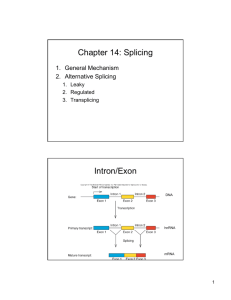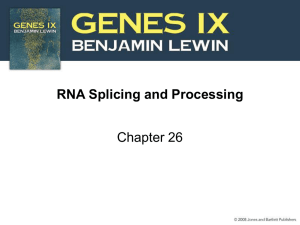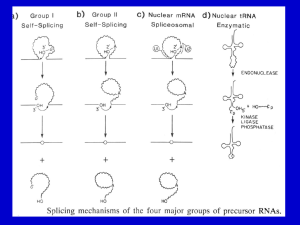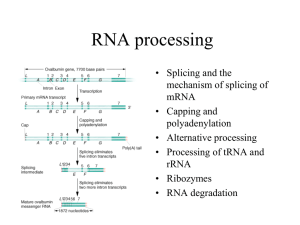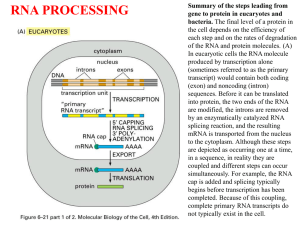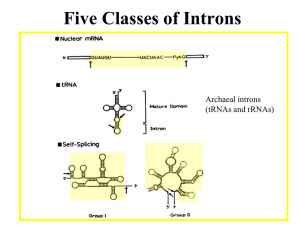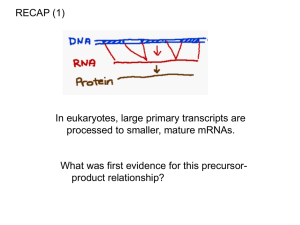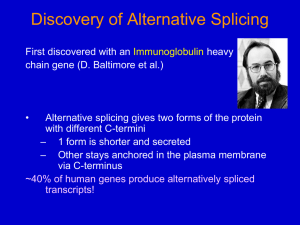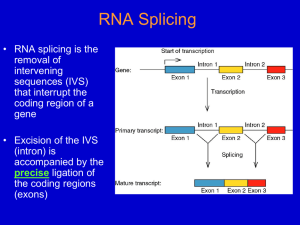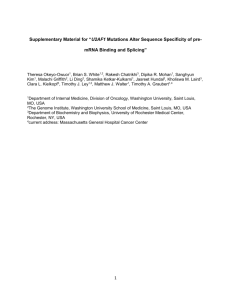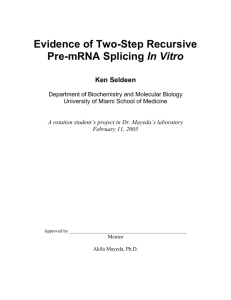Chapter 26
advertisement
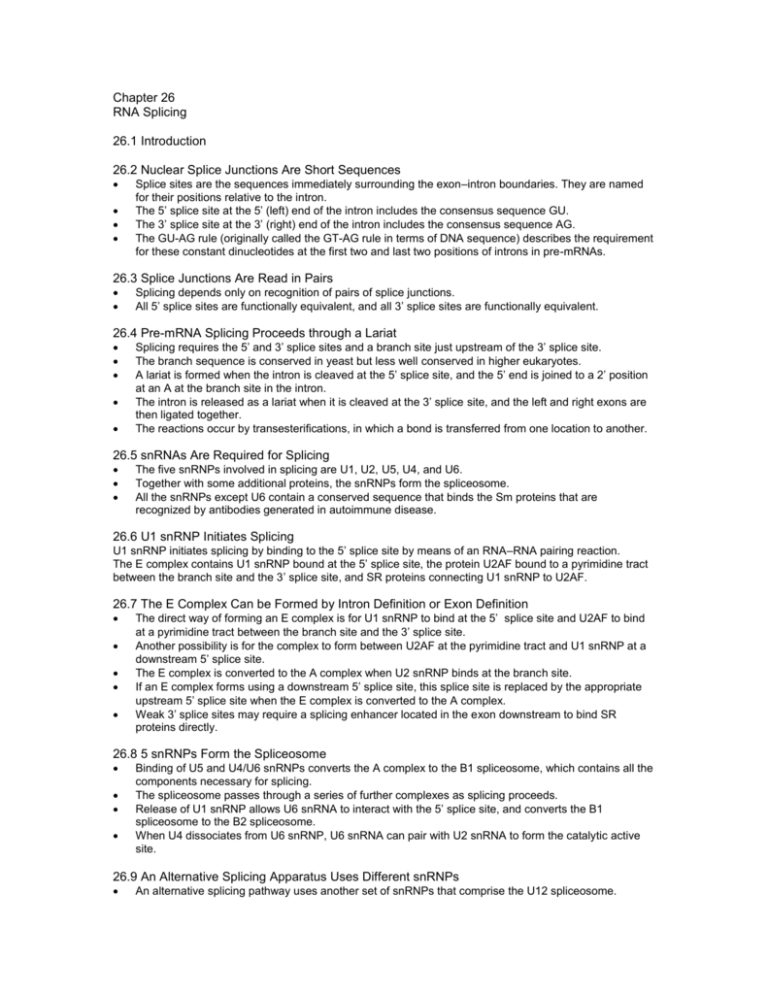
Chapter 26 RNA Splicing 26.1 Introduction 26.2 Nuclear Splice Junctions Are Short Sequences Splice sites are the sequences immediately surrounding the exon–intron boundaries. They are named for their positions relative to the intron. The 5’ splice site at the 5’(left) end of the intron includes the consensus sequence GU. The 3’ splice site at the 3’ (right) end of the intron includes the consensus sequence AG. The GU-AG rule (originally called the GT-AG rule in terms of DNA sequence) describes the requirement for these constant dinucleotides at the first two and last two positions of introns in pre-mRNAs. 26.3 Splice Junctions Are Read in Pairs Splicing depends only on recognition of pairs of splice junctions. All 5’ splice sites are functionally equivalent, and all 3’ splice sites are functionally equivalent. 26.4 Pre-mRNA Splicing Proceeds through a Lariat Splicing requires the 5’ and 3’ splice sites and a branch site just upstream of the 3’ splice site. The branch sequence is conserved in yeast but less well conserved in higher eukaryotes. A lariat is formed when the intron is cleaved at the 5’splice site, and the 5’ end is joined to a 2’position at an A at the branch site in the intron. The intron is released as a lariat when it is cleaved at the 3’ splice site, and the left and right exons are then ligated together. The reactions occur by transesterifications, in which a bond is transferred from one location to another. 26.5 snRNAs Are Required for Splicing The five snRNPs involved in splicing are U1, U2, U5, U4, and U6. Together with some additional proteins, the snRNPs form the spliceosome. All the snRNPs except U6 contain a conserved sequence that binds the Sm proteins that are recognized by antibodies generated in autoimmune disease. 26.6 U1 snRNP Initiates Splicing U1 snRNP initiates splicing by binding to the 5’ splice site by means of an RNA–RNA pairing reaction. The E complex contains U1 snRNP bound at the 5’splice site, the protein U2AF bound to a pyrimidine tract between the branch site and the 3’ splice site, and SR proteins connecting U1 snRNP to U2AF. 26.7 The E Complex Can be Formed by Intron Definition or Exon Definition The direct way of forming an E complex is for U1 snRNP to bind at the 5’ splice site and U2AF to bind at a pyrimidine tract between the branch site and the 3’splice site. Another possibility is for the complex to form between U2AF at the pyrimidine tract and U1 snRNP at a downstream 5’ splice site. The E complex is converted to the A complex when U2 snRNP binds at the branch site. If an E complex forms using a downstream 5’splice site, this splice site is replaced by the appropriate upstream 5’splice site when the E complex is converted to the A complex. Weak 3’ splice sites may require a splicing enhancer located in the exon downstream to bind SR proteins directly. 26.8 5 snRNPs Form the Spliceosome Binding of U5 and U4/U6 snRNPs converts the A complex to the B1 spliceosome, which contains all the components necessary for splicing. The spliceosome passes through a series of further complexes as splicing proceeds. Release of U1 snRNP allows U6 snRNA to interact with the 5’ splice site, and converts the B1 spliceosome to the B2 spliceosome. When U4 dissociates from U6 snRNP, U6 snRNA can pair with U2 snRNA to form the catalytic active site. 26.9 An Alternative Splicing Apparatus Uses Different snRNPs An alternative splicing pathway uses another set of snRNPs that comprise the U12 spliceosome. The target introns are defined by longer consensus sequences at the splice junctions, but usually include the same GU-AG junctions. Some introns have the splice junctions AU-AC, including some that are U1-dependent and some that are U12-dependent. 26.10 Splicing Is Connected to Export of mRNA The REF proteins bind to splicing junctions by associating with the spliceosome. After splicing, they remain attached to the RNA at the exon–exon junction. They interact with the transport protein TAP/Mex that exports the RNA through the nuclear pore. 26.11 Group II Introns Autosplice via Lariat Formation Group II introns excise themselves from RNA by an autocatalytic splicing event. The splice junctions and mechanism of splicing of group II introns are similar to splicing of nuclear introns. A group II intron folds into a secondary structure that generates a catalytic site resembling the structure of U6-U2-nuclear intron. 26.12 Alternative Splicing Involves Differential Use of Splice Junctions Specific exons may be excluded or included in the RNA product by using or failing to use a pair of splicing junctions. Exons may be extended by changing one of the splice junctions to use an alternative junction. Sex determination in Drosophila involves a series of alternative splicing events in genes coding for successive products of a pathway. P elements of Drosophila show germlinespecific alternative splicing. 26.13 trans-splicing Reactions Use Small RNAs Splicing reactions usually occur only in cis between splice junctions on the same molecule of RNA. trans-splicing occurs in trypanosomes and worms where a short sequence (SL RNA) is spliced to the 5’ ends of many precursor mRNAs. SL RNA has a structure resembling the Sm-binding site of U snRNAs and may play an analogous role in the reaction. 26.14 Yeast tRNA Splicing Involves Cutting and Rejoining tRNA splicing occurs by successive cleavage and ligation reactions. 26.15 The Splicing Endonuclease Recognizes tRNA An endonuclease cleaves the tRNA precursors at both ends of the intron. The yeast endonuclease is a heterotetramer with two (related) catalytic subunits. It uses a measuring mechanism to determine the sites of cleavage by their positions relative to a point in the tRNA structure. The archaeal nuclease has a simpler structure and recognizes a bulge-helix-bulge structural motif in the substrate. 26.16 tRNA Cleavage and Ligation Are Separate Reactions Release of the intron generates two halftRNAs that pair to form the mature structure. The halves have the unusual ends 5’ hydroxyl and 2’—3’ cyclic phosphate. The 5’—OH end is phosphorylated by a polynucleotide kinase, the cyclic phosphate group is opened by phosphodiesterase to generate a 2’–phosphate terminus and 3’–OH group, exon ends are joined by an RNA ligase, and the 2’– phosphate is removed by a phosphatase. 26.17 The Unfolded Protein Response Is Related to tRNA Splicing Ire1p is an inner nuclear membrane protein with its N-terminal domain in the ER lumen, and its Cterminal domain in the nucleus. Binding of an unfolded protein to the N-terminal domain activates the C-terminal nuclease by autophosphorylation. The activated nuclease cleaves Hac1 mRNA to release an intron and generate exons that are ligated by a tRNA ligase. The spliced Hac1 mRNA codes for a transcription factor that activates genes coding for chaperones that help to fold unfolded proteins. 26.18 The 3Ends of polI and polIII Transcripts Are Generated by Termination RNA polymerase I terminates transcription at an 18-base terminator sequence. RNA polymerase III terminates transcription in poly(U)4 sequence embedded in a G-C-rich sequence. 26.19 The 3Ends of mRNAs Are Generated by Cleavage and Polyadenylation The sequence AAUAAA is a signal for cleavage to generate a 3’end of mRNA that is polyadenylated. The reaction requires a protein complex that contains a specificity factor, an endonuclease, and poly(A) polymerase. The specificity factor and endonuclease cleave RNA downstream of AAUAAA. The specificity factor and poly(A) polymerase add 200 A residues processively to the 3’end. AU-rich sequences in the 3’ tail control cytoplasmic polyadenylation or deadenylation during Xenopus embryonic development. 26.20 Cleavage of the 3’ End of Histone mRNA May Require a Small mRNA19 Histone mRNAs are not polyadenylated. o Their 3’ ends are generated by a cleavage reaction that depends on the structure of the mRNA. The cleavage reaction requires the SLBP to bind to a stem-loop structure and the U7-snRNA to pair with an adjacent single-stranded region. 26.21 Production of rRNA Requires Cleavage Events The large and small rRNAs are released by cleavage from a common precursor RNA. 26.22 Small RNAs Are Required for rRNA Processing. The C/D group of snoRNAs is required for modifying the 2’ position of ribose with a methyl group. The H/ACA group of snoRNAs is required for converting uridine to pseudouridine. In each case the snoRNA base pairs with a sequence of rRNA that contains the target base to generate a typical structure that is the substrate for modification.
